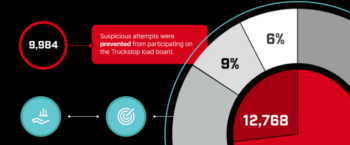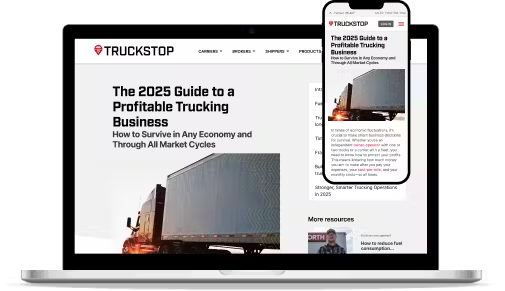Your 12-Step Guide on How to Become a Freight Broker

Ready to become
a freight broker?
Let us help you navigate the nitty-gritty.
Freight and shipping in the United States is a billion-dollar industry. A freight broker plays a key role in managing the millions of loads transported each year. Freight brokers connect truckers with consistent work and help shippers find cost-effective transportation of their cargo.
The high demand for the fast movement of goods presents a real opportunity to carve out a profitable career as a freight broker. If you have a passion for logistics, a knack for problem-solving, and a mix of people, practical, and organizational skills, freight brokering could be the right career for you.
This article provides a step-by-step guide to starting a freight brokerage business. We cover everything from average salaries to licensing and insurance types.
What does a freight broker do?
Think of freight brokers as intermediaries between shippers and carriers. They help shippers find reliable carriers to transport their goods while helping carriers locate cargo to transport. Freight brokers simplify shipment logistics by negotiating rates, coordinating shipments, and ensuring smooth deliveries.
A freight broker’s responsibilities include:
- Matching shippers and carriers: Brokers act as liaisons between businesses needing transportation services and those providing transportation.
- Negotiating rates: Freight brokers negotiate pricing between parties for fairness and profitability.
- Managing shipments: Brokers help coordinate logistics, such as scheduling deliveries and collections.
- Building relationships: Establishing relationships with shippers and carriers builds a broker’s reputation and client base.
- Solving problems: Brokers address issues like cargo damage, delays, and other issues.
- Carrier onboarding: Before shippers hire carriers, freight brokers vet them to make sure they hold a valid operating authority and are legitimate, trustworthy, and compliant with insurance and other requirements. The vetting process should weed out any carriers with risk potential.
- Carrier monitoring: Freight brokers monitor carriers throughout the freight lifecycle to ensure that carrier’s status remains in good standing.
Independent freight brokers are their own bosses. They often work from home, set their own hours, and earn a generous salary plus commission.
What’s the difference between a freight broker and a freight agent?
Freight brokers and freight agents differ in a few key ways:
- Freight brokers have their own broker authority, license, and insurance, allowing them to legally arrange freight movement. Brokers earn a salary plus a commission.
- Freight agents coordinate freight movement under a broker’s operating authority. They work on commission based on the dollar value of freight contracts they negotiate for brokers.
If you want to know how to become a freight agent, there are plenty of online resources to help you out.
How does a freight broker make money?
Freight brokerage is the business of connecting shippers and carriers. Companies often post freight jobs to a load board. These platforms allow carriers to search for, bid on, and accept loads.
A freight broker makes money by helping shippers find the right carrier at the right price. This is called load- or freight-matching. Shippers benefit by saving money on competitive marketplace rates and building relationships with brokers who consistently provide excellent service. The more shipper clients a broker has and the more loads they’re able to move, the greater the salary. The key is to move as much freight as possible while keeping costs and overhead low.
The national average freight broker salary is around $62,000. The average commission per year is around $28,000. Location, reputation, and experience can influence broker salaries.
12 Steps to become a freight broker
The path to becoming a freight broker is different for everyone, but here are some basic steps to get you off the ground:
1. Start with proper training.
Sufficient industry knowledge is crucial for a successful business. Prior experience in freight and logistics as a trucker, manager, or dispatcher is also an asset. If you lack experience, freight broker training programs can give you an understanding of the industry. While not a legal requirement, they can be extremely beneficial.
Online training classes are often self-paced, with a completion window of up to six months. These courses cover transportation types, regulations, recordkeeping, rate-setting, and other aspects of brokering. Some programs provide templates for contracts, invoices, and other essential business documents.
A fast way to get hands-on experience is by starting as an entry-level broker in a brokerage business. Earning a salary while learning the ropes will prepare you well for step two.
2. Set up your business.
Choose a name that helps identify your business and is easy to market. Once you have a shortlist, check them on the United States Patent and Trademark Office (USPTO) website to see if they’re available. After choosing your name, you’re well on your way to applying for your broker authority.
Most states allow businesses to register their name and business entity at the same time. You must register your business as a sole proprietor, partnership, or limited liability corporation (LLC).
A sole proprietorship is simple to set up if you plan to work alone. A partnership is ideal if you’re going into business with others. However, both options can expose you to financial liability resulting from business operations. An LLC shields your personal assets from business-related liability.
3. Apply for your freight broker authority.
The Federal Motor Carrier Safety Administration (FMCSA) Unified Registration System (URS) handles authority registrations. You must complete the Application for Motor Property Carrier and Broker Authority (form OP-1). This form is a requirement for becoming a licensed freight broker.
Each individual operating authority application costs $300. Including both applications on the same form costs $600. Submitting form OP-1 online gets you an immediate grant letter and motor carrier (MC) number. These documents confirm your freight broker license application but do not authorize operation. You must still get the required insurance and surety and choose process agents for each state you plan to operate in.
4. Select a process agent.
A freight brokerage business must have a process agent in each state where it operates. The process agent receives legal documents for the freight brokerage in legal proceedings. Process agents must provide a physical location instead of a P.O. box. You can find a list of agents on the FMCSA website.
You can act as your own process agent in your state. You can also hire a salaried employee or use a process agent service. These agents charge fees for their service.
5. Acquire a surety bond.
In 2013, the federal government increased the mandatory freight broker bond from $10,000 to $75,000. Based on personal credit and financial health, bonds may cost as little as $750 per year. Brokers must pay the full premium up front. Some bond companies offer financing for monthly surety bond payments.
Your bond company will give you form BMC-84 for your freight broker surety bond. You must submit this form to the FMCSA within 90 days of filing your OP-1.
6. Purchase insurance.
Most companies won’t allow freight brokers to operate on their behalf without:
- Contingent cargo insurance: In the case of lost or damaged cargo, this insurance protects freight industry professionals from financial
- General liability insurance:This insurance covers third-party property damage or injury claims.
While the federal government doesn’t require these coverages, they shield you from personal liability.
Onboard with confidence
Take a deep dive into risk mitigation for freight brokers.
7. Check state tax regulations.
You must ensure your company follows state regulations, including business registration requirements and taxes. Understand the records you need to keep and the filing requirements in your operating areas.
8. Develop a business plan.
Freight brokering may seem simple. You contract with company A to organize the shipping of their load and contract with company B to haul the cargo. Your profit comes from the difference between what A pays and what B charges. However, there’s much more to consider, and a thorough business plan helps you start with a solid foundation, which will provide structure to your operations.
Consider these questions as you draft your plan:
- How will you manage the gap between money going out and money coming in?
- How will you cover your startup equipment, insurance, and licensing costs?
- When and how will you repay any business loans?
- If relevant, how will you reach out to your contacts or network from previous roles to build your business?
A well-developed business plan should account for all those issues. Set clear growth and revenue targets and achievable milestones. Determine regular check-in points to ensure you are on schedule with your plan.
9. Arrange financing.
If you have cash reserves on hand, you may be able to float the cash flow of your new business without help. If not, getting a line of credit from a bank can help. Remember—you will need to pay the truckers before you receive payment from the shipper.
Knowing your initial operating costs can help you approach financial institutions for a business loan or credit. They may use your personal assets to secure funding, or you may need to prove your company’s viability. With funding in place, you can start operating your business.
10. Finalize your broker contracts.
Here’s where your experience or education can come in handy. Freight broker training courses often provide document kits that you can use to carry out your business.
You must set up and maintain shipping and carrier contracts while keeping track of shipping records. Have a lawyer review your forms and contract templates to ensure suitability for your freight broker company. And remember to keep proof of your qualifications!
11. Find shipper and carrier clients.
If you have previous industry experience, you may already have a list of potential clients. Building relationships with shippers and carriers will cement your reputation as a reliable broker. More contracts mean more profit.
Whether you have an established network or you’re just starting out, the best way to connect loads to trucks is with a load board. Online broker load boards like Truckstop give you access to thousands of shipper leads, trucks, and drivers. You can also use the boards to research cargo rates in the shipping lanes you intend to operate.
Here are a few benefits of load boards:
- They provide a single source of reliable drivers and trucks.
- The Truckstop Load Board verifies each carrier.
- Choose carriers based on ratings, reviews, and history.
- You can perform unlimited truck, lane, and load searches.
- Automated tools allow up to 80% faster carrier onboarding.
- Negotiation tools helps you make informed pricing decisions.
- Data gives you valuable insights into forecasting trends you can use for planning.
12. Find shipper and carrier clients.
Now that you know how to become a freight broker, it’s time to start brokering. If you nailed steps one to 11, you’re ready to make your freight brokerage business a success.
Trust Truckstop as your freight broker partner.
You can use a load board board like Truckstop to post loads and manage your jobs. Truckstop provides real-time updates that allow you to see and respond to trucks and drivers the moment they post. The more loads you broker, the faster your business grows.
Improve your broker ratings by impressing customers on both sides of the industry. Shippers and carriers use Truckstop to vet quality brokers, giving you an edge in growing your business.
Contact Truckstop for a demo, and choose your load board today to get started!
Tune in to
Freight Nation: A Trucking Podcast.
Listen in as seasoned brokers share practical knowledge.
Topics:

Find out how our platform gives you the visibility you need to get more done.
Get helpful content delivered to your inbox.
Schedule a demo.
Find out how our platform gives you the visibility you need to get more done.






